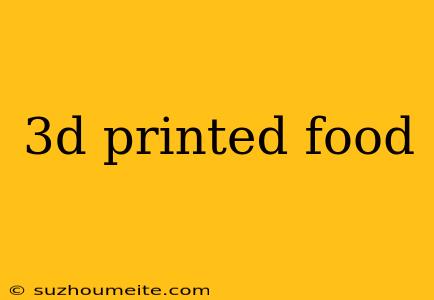3D Printed Food: The Future of Culinary Innovation
Introduction
Imagine a world where food can be created at the touch of a button, with intricate designs and shapes that are both visually stunning and delicious. Welcome to the world of 3D printed food, where culinary innovation meets cutting-edge technology. In this article, we'll delve into the fascinating realm of 3D printed food, exploring its benefits, possibilities, and the potential to revolutionize the way we produce and consume food.
What is 3D Printed Food?
3D printed food uses a combination of ingredients and a 3D printing machine to create customized food products with complex geometries and designs. The process involves layering ingredients such as chocolates, cookies, or pureed foods to create a three-dimensional structure. The ingredients are extruded through a heated nozzle, which is precisely controlled to create the desired shape and design.
Benefits of 3D Printed Food
Customization
One of the most significant advantages of 3D printed food is the ability to customize food products to meet individual tastes and dietary needs. With 3D printing, it's possible to create food products with specific nutritional content, texture, and flavor profiles.
Increased Efficiency
3D printed food can significantly reduce food waste and increase efficiency in food production. By creating food products with precise control over ingredients and portion sizes, 3D printing can minimize food waste and optimize resource allocation.
Improved Nutrition
3D printed food can provide essential nutrients and vitamins to people with specific dietary needs. For example, 3D printed food can be designed to provide extra calcium for osteoporosis patients or customized nutrition for athletes.
Creativity and Innovation
3D printed food offers endless possibilities for creative and innovative food designs. Chefs and food designers can create intricate and visually stunning food products that are both Instagram-worthy and delicious.
Potential Applications
Space Exploration
3D printed food can be a game-changer for space exploration. By creating food products with specific nutritional content and shelf life, 3D printing can provide a sustainable food source for astronauts on long-duration space missions.
Healthcare
3D printed food can be used to create customized nutrition for patients with specific dietary needs. For example, 3D printed food can provide essential nutrients for patients with swallowing disorders or digestive issues.
Food Sustainability
3D printed food can reduce food waste and optimize resource allocation in the food industry. By creating food products with precise control over ingredients and portion sizes, 3D printing can minimize environmental impact and promote sustainable food production.
Challenges and Limitations
While 3D printed food holds immense potential, there are several challenges and limitations to consider:
Food Safety
Ensuring food safety is a critical concern in 3D printed food. The risk of contamination and foodborne illnesses must be mitigated through proper sanitization and handling procedures.
Scalability
Currently, 3D printed food is a labor-intensive and time-consuming process. Scaling up production to meet commercial demands remains a significant challenge.
Taste and Texture
The taste and texture of 3D printed food can be inconsistent, and the lack of human sensory feedback can affect the overall dining experience.
Conclusion
3D printed food is an exciting and rapidly evolving field that has the potential to revolutionize the way we produce and consume food. While there are challenges and limitations to consider, the benefits of customization, increased efficiency, and improved nutrition make 3D printed food an exciting area of innovation in the culinary world. As technology advances and the industry matures, we can expect to see widespread adoption of 3D printed food in various industries, from healthcare to space exploration.
